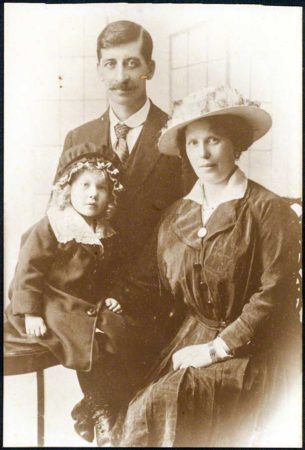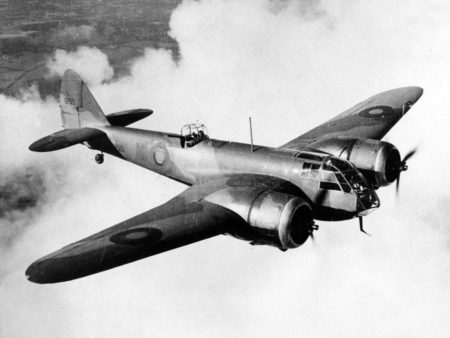There were only two times during World War II when Allied troops joined forces in battle with the German Wehrmacht and the Waffen-SS.
These incidents are known as “Operation Cowboy” and the “Battle of Castle Itter.” Both battles were fought in the very late stages of the war ⏤ Operation Cowboy on 28 April 1945 and Castle Itter on 5 May 1945.
ADVANCE NOTICE FOR
MY HALLOWEEN 🎃 PRESENTATION
30 OCTOBER 2024
“Cemetery Crawl: Unearthing Parisian Legends”
Meet Some Interesting Occupants
BONJOUR PARIS
Bonjour Paris members click here.
Non-members click here, $10 fee.
FranceMedia Group publishes magazines, both in print and digitally, that cover various aspects of France. Their brands include France Today, Complete France, Bonjour Paris, French Entrée, Taste of France, France PropertyShop, and French Property.
Click here to visit the FranceMedia Group web-site.
Did You Know?
Did you know that improvising during a war is critical (as is being lucky among other requirements ⏤ just ask Napoléon). It’s kind of like in Normandy right after D-Day when the First Army’s infantry and tanks couldn’t penetrate the deadly country hedgerows used by the Germans as natural physical barriers. Some soldiers came up with the idea of attaching multiple blades to the front of the M-4 Sherman tanks. Operating much like bulldozers or the “cow catcher” of a locomotive, the “Dozer” tanks could bust through the hedgerows and create an unimpeded lane for the men and tanks.
Another pivotal wartime improvision was devised by Beatrice “Tilly” Shilling (1909−1990). She was a talented British aeronautical engineer who graduated with an electrical engineering bachelor’s degree and master’s degree in mechanical engineering from the Victoria University of Manchester (one of only two women to earn an EE degree at that time). From the earliest age, Tilly was buying hand tools and working on mechanical problems. She was especially enamored with motorcycles and by the age of twenty, Tilly published a piece on how to build a wireless set.
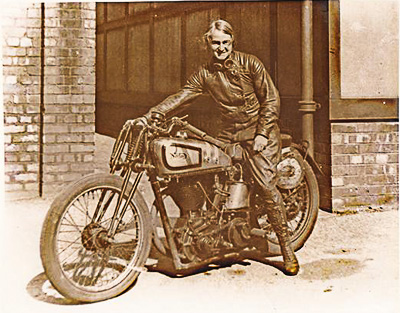
In 1936, Tilly was recruited to join the Royal Aircraft Establishment (RAE), a British research organization specializing in aircraft and aerospace issues. One of the immediate problems faced by the Hurricane and Spitfire pilots during the Battle of Britain in 1940 were the aircraft engines. The Rolls-Royce Merlin engines stalled out when the aircraft went into a dive. The negative g-force flooded the engine’s carburetor with fuel resulting in a stall ⏤ German fighter aircraft used fuel injection engines and did not have this problem. Tilly went to work and quickly invented a fuel restrictor to solve the problem of fuel flooding. It was so simple to install that the RAF never had to take their planes out of service. Tilly led a small team to all the RAF air stations and rapidly installed the restrictors on the fighter planes. (Tilly always traveled by motorcycle.) Tilly’s restrictor was used until 1943 when Rolls-Royce began building their engines with a pressure carburetor.
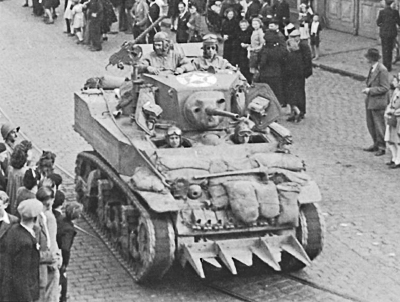
Tilly worked for RAE until her retirement in 1969. She was responsible for designing the bobsled used by the RAF Olympic team. After the war, Tilly and her husband became involved in racing motorcycles and cars. Despite being awarded the OBE in 1949, her degrees, and joining the Institution of Mechanical Engineers (allowed only under her married name), Tilly faced discrimination her entire career at RAE. As a woman, she was prohibited from entering certain buildings including the RAE Senior Mess and was restricted from working at night. Furthermore, promotions were reserved only for men.
Beatrice Shilling passed away from cancer in November 1990. Her husband, a former World War II RAF bomber pilot, followed in death six years later.
“Operation Cowboy”
We all know about Hitler’s obsession to create the “Master Aryan Race.” However, most people are unaware that he also wanted to create a master race of “Aryan” horses.
After Hitler annexed Austria in 1938 (the “Anschluss”), he ordered the Lipizzaner breeding mares to be moved from the Spanish Riding School in Vienna to an experimental farm in the town of Hostouň, Czechoslovakia. (Today, Hostouň is part of the Czech Republic on the eastern border of Germany.) In 1914, a military horse breeding operation was moved to Hostouň where the studs were eventually evacuated to three farms (Zwirschen, Hassalitz, and Taschlowitz) during World War I. During the interwar years (i.e., the years between the two world wars), the horses born and raised in Hostouň achieved international acclaim including competition in the Berlin 1936 Olympics. In 1938, Hostouň, or Hostau (the German name) was part of the Sudetenland annexed by Germany (the infamous “Munich Agreement”) and between 1938 and 1945, the Nazi government occupied Czechoslovakia with Hostau as part of the German administrative region known as Reichsgau Sudetenland. The Germans immediately took over the Hostau stud farm with the intent of using the horses in their calvary regiments. By 1942, most of the European Lipizzaner horses had been evacuated to the Hostau farm.
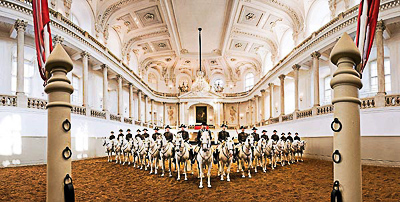
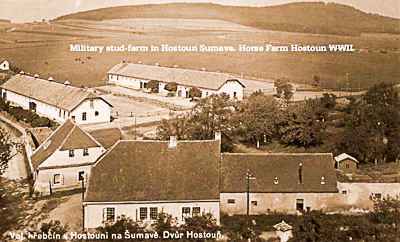
Lipizzaner horses were not unique to Vienna and Austria. Lipizzaners were bred and raised on private farms in Macedonia, Croatia, Italy, Hungary, Slovakia, and Transylvania. However, it was the Spanish Riding School, founded in 1572, that gained world-wide recognition as the hub of Lipizzaner activities. In 1939, Alois Podhajsky (1898−1973) became director of the school and remained in that position until 1965. Under his direction, the Lipizzaner horses and riders were trained in classical dressage. (Podhajsky won the bronze medal in dressage at the 1936 Berlin Olympics.) Podhajsky was an Austrian military officer and after the German Anschluss, he joined the Wehrmacht as a major. Throughout the war, Podhajsky was concerned for the safety of the horses because of the continuous Allied bombings. However, as the war progressed, people began to suffer as food sources dwindled and they turned their attention to horses as a source of food.
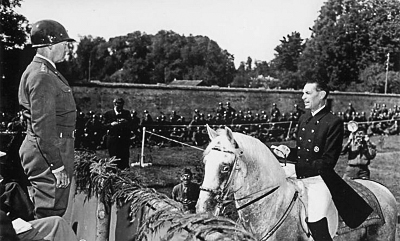
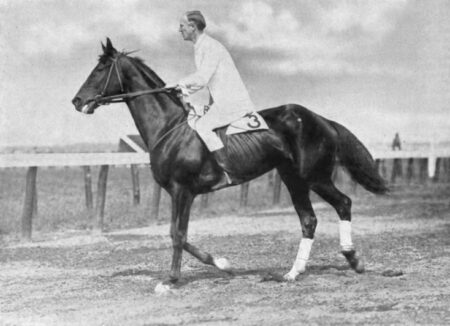
During the late stages of the war, the race to Berlin was quite intense. Approaching from the east was the Soviet Army and from the west was Gen. George Patton and his Third Army. Each was determined to be the first to enter Berlin (despite Gen. Eisenhower’s orders to hold back and give the Soviets the green light to take the city). Squeezed between these two massive armies advancing toward Prague was Hostau and its Lipizzaner horses. The German commander of the horse farm, Lt. Col. Hubert Rudofsky and the farm’s veterinarian, Dr. Rudolf Lessing believed the horses would be killed for food by the Soviet troops. (They knew the Russians had killed the entire collection of Royal Hungarian Lipizzaner horses.) By now, they were desperate to feed and care for more than seven hundred horses (350 Lipizzaners, Arabians, and other full-blooded breeds). Unfortunately, the borders were closed, and the last escape route for the horses was blocked by the German army, or what remained of it.
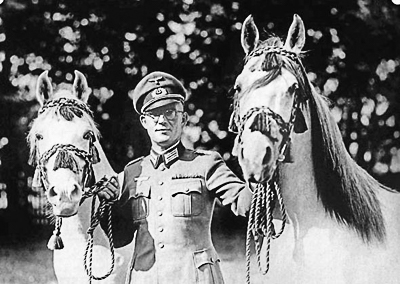
By chance, a Luftwaffe general staff officer on his way to surrender to the Americans happened to appear at Rudofsky’s office. Lt. Col. Walter Holters, a horse lover, realized the horses were in imminent danger and suggested to Rudofsky that after he give himself up to the Americans, he would try to obtain their assistance in saving the horses. During his interrogation by the 42nd Cavalry Reconnaissance Squadron of the 2nd Cavalry Group, Holters revealed the predicament of the Lippizaners. He met with the commander of the 2nd Cavalry, Col. Charles Hancock Reed (1900−1980), who was also a fan of horses (of course he was, he commanded a cavalry group). Reed ultimately reported to Patton and was under orders not to cross the Bavarian-Bohemian border due to the terms of the Yalta Conference (the Hostau farm was only a few miles across the border). Reed put a call into Patton, explained the situation, and the former calvary officer now the newly promoted four-star general gave the order to “Get them, make it fast!”
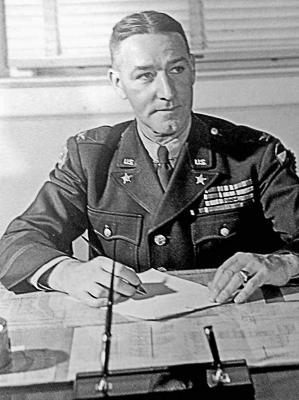
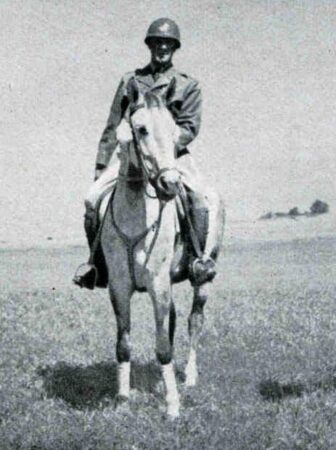
Dr. Lessing made it across the border to meet with Col. Reed where he pleaded for assistance in rescuing the horses. In the meantime, a spit and polish German Wehrmacht officer, Gen. Schulze, took over the horse farm. Learning that Lessing had crossed the border, the general threatened Col. Rudofsky with execution. By this time, Reed realized his only option to rescue the horses was to immediately march on Hostau and get there before the Russians.
Col. Reed was cautioned that a SS unit stood between the Americans and the farm. Knowing he would overrun the enemy, Reed ordered “Operation Cowboy” to commence with the armored cars and tanks of the 42nd Cavalry Reconnaissance Squadron taking the lead to rescue the horses. This squadron was well-known to the Germans as the “Ghosts of Patton’s Army” due to their successful missions behind German lines. Dr. Lessing and Capt. Thomas Stewart (1915−2011), Reed’s adjutant, rode back to Hostau to obtain Rudofsky’s formal surrender. Unfortunately, they did not know a German Wehrmacht general was in charge of defending the farm and Rudofsky was now a subordinate officer forced to take orders including refusing to surrender and transferring the horses to safety.
With light armor and tanks and assistance from artillery barrages by the XII Corps, Maj. Robert Andrews brought his force of 325 men twenty miles through German-held territory (including the 11th Panzer Division) to Hostau and the stud farm. Conflict at the border with the Panzer tanks resulted in minimal casualties and Andrews secured the farm. Enlisting the aid of liberated Allied POWs, captured German soldiers and even Russian Cossacks, a plan was devised to move the horses. However, the farm was attacked twice by Waffen-SS troops. The attacks were repelled, and the SS retreated. The horses were either mounted or herded for the evacuation just before Soviet tanks appeared. Near the border, the horses were loaded into trucks and driven to safety behind American lines.
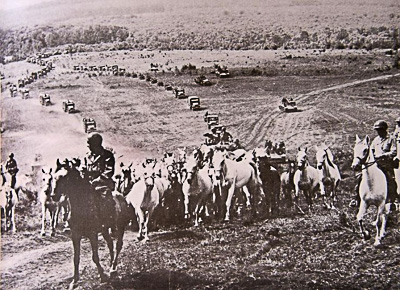
On 7 May, Col. Podhajsky contacted Gen. Patton requesting protection of the Lipizzaner horses. Patton was told that Reed and his 2nd Cavalry “had already taken care of it.”
When asked why the Americans agreed to save the Lipizzaner horses, Col. Reed responded, “We were so tired of death and destruction, we wanted to do something beautiful.”
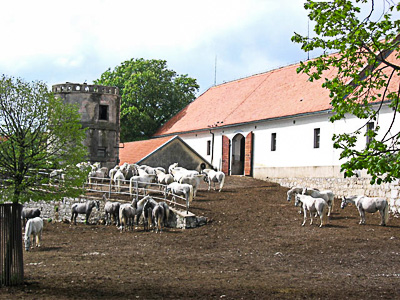

“Battle of Castle Itter”
The surrender documents had not been signed but the war was essentially over by 5 May 1945. Hitler had committed suicide five days earlier and within two days, Gen. Alfred Jodl (1890−1946) would surrender to Gen. Eisenhower in Reims, France formally ending the war in the European theater. Despite this, some German forces including the 17th SS Panzergrenadier Division, continued to attack enemy forces in Austria.
Click here to watch the video The Battle of Itter Castle.
Castle Itter
Schloß (i.e., castle) Itter was built in the 19th-century in Itter, a small village in Austria. Located about five miles from Wörgl and 40 miles from Innsbruck, the castle sits on a hill overlooking the Brixental valley. Prior to the annexation of Austria by Hitler (i.e., the Anschluss), the castle was owned by Franz Grüner (1879−1953), an Austrian politician.
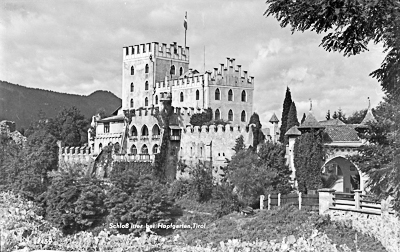
By late 1940, the German government leased the castle from Grüner but in February 1943, SS-Obergruppenführer Oswald Pohl (1892−1951), a key figure of the “Final Solution” and executed for crimes against humanity, was ordered to seize the castle. Schloß Itter was converted to a prison under the jurisdiction of the Dachau concentration camp. Its purpose was to hold high-profile French prisoners as hostages with Dachau inmates used as laborers around the castle. Some of the French prisoners included former prime ministers Édouard Daladier (1884−1970) and Paul Reynaud (1878−1966), former military commanders Maxime Weygand (1867−1965) and Maurice Gamelin (1872−1958), and Charles de Gaulle’s sister and résistant, Marie-Agnès de Gaulle (1889−1982).
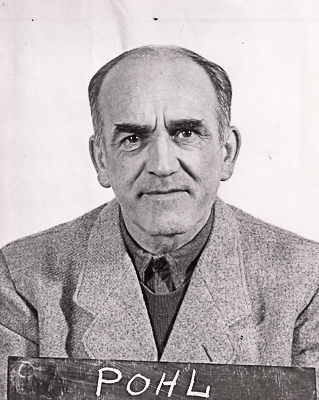
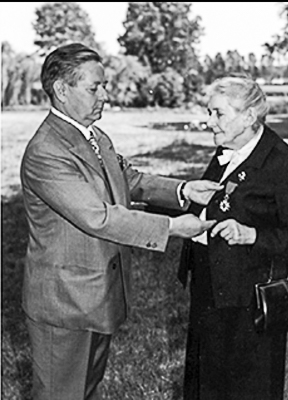
Pre-Battle
As part of an escape plan by the prisoners on 3 May 1945, Zvonimir Čučković, a Croatian forced laborer, left the castle on a mission to contact the Allies and seek assistance. (He was allowed to leave because he convinced the guards he was on an errand for the castle’s commander.) The Croatian carried a letter which was supposed to be given to the first American soldier he met. Rather than walking to German-occupied Wörgl, Čučković changed direction toward Innsbruck where he encountered an American advance party. The castle was located outside the jurisdiction of the army division, but Maj. John T. Kramers (1917−2012) decided to disobey orders and put together a small rescue group.
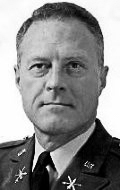
Čučković failed to return to the castle and the former Dachau commandant, SS-Obersturmführer Eduard Weiter (1889−1945), fled to Castle Itter where he reportedly committed suicide. The prison’s commander, SS-Hauptsturmführer Sebastian Wimmer (1907−unknown), and his SS-Totenkopfverbände guards (i.e., “Death’s-Head Battalions” in charge of administration of the concentration camps) now feared for their lives and fled the castle. At this point, the prisoners were in charge but couldn’t leave the castle due to the German military presence in the area. Despite arming themselves, the prisoners feared an attack by surrounding SS troops as they retreated from the advancing Allied armies.
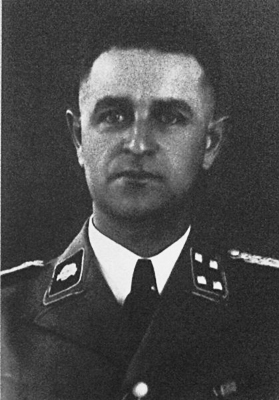
Not knowing whether Čučković had succeeded or not, the prisoners sent out a second emissary, Andreas Krobot, with the same goal of reaching the Allied army and obtaining assistance for liberation. On 4 May, Krobot ran into Wehrmacht officer, Maj. Josef “Sepp” Gangle (1910−1945) and outlined the situation at the castle. Gangle had become disillusioned with the Nazis and led a small group of men alongside the Austrian resistance. He immediately went to Lt. John “Jack” C. Lee, Jr. (1918−1973), a tank commander in an American reconnaissance unit. (Lee would be promoted to captain several days after the battle.) The two of them reconnoitered the castle and returned to organize a rescue party. Together with 14 U.S. soldiers and ten of Gangle’s men, they drove to the castle to “liberate” the prisoners.
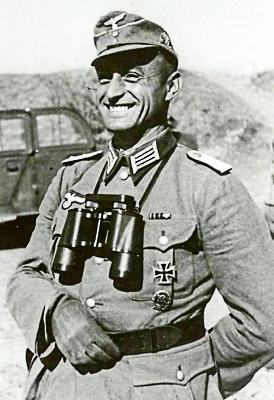
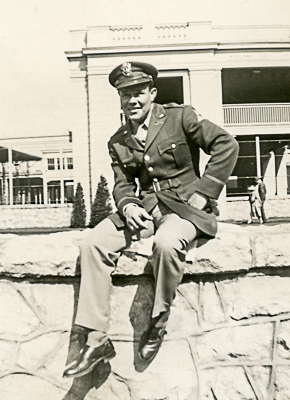
The Battle
On the morning of 5 May, the 17th SS Panzergrenadier Division “Götz von Berlichingen” under the command of SS-Sturmbannführer Georg Bochmann (1913−1973) attacked the castle. Lee and Gangle’s small group of defenders were joined by a young resistance fighter named Hans Waltl, several Wehrmacht soldiers, and a German defector, Waffen-SS Hauptsturmführer Kurt-Siegfried Schrader (1916−unknown). The prisoners had already picked up weapons left behind by the former guards and joined in the fight that included Lee’s tank (the “Besotten Jenny”) positioned at the castle’s entrance gate.
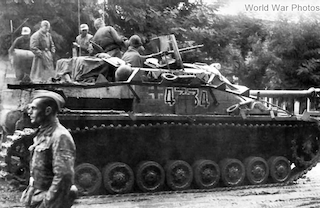

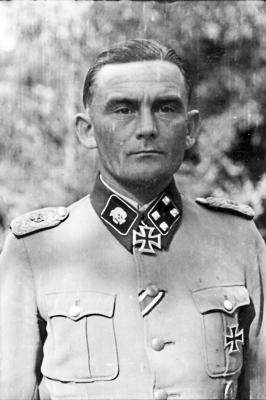
The Waffen-SS troops destroyed the tank, damaged the castle’s wall, and killed Gangle as he was attempting to save the life of Paul Reynaud. By 4:00 pm, the castle’s defenders’ ammunition was about to run out. At about the same time, a column of U.S. tanks from the 142nd U.S. Infantry Regiment appeared. They were part of Maj. Kramers’s rescue force. Lt. Lee and his small band of fighters were able to withstand the attack of seasoned SS men and their Panzer tanks and liberated Schloß Itter’s prisoners. Four days later, Bochmann surrendered his men and armaments to the Americans in the Rottach-Egern region. The French prisoners returned to Paris on 10 May.
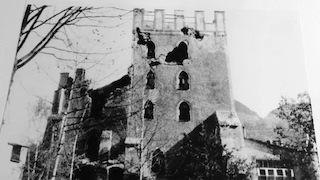
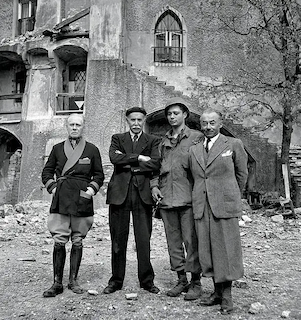
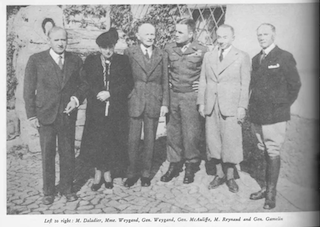
Capt. Lee was awarded the Distinguished Service Cross while Maj. Gangle is remembered as an Austrian national hero and a “Hero of the Austrian Resistance.” A street in Wörgl is named after him.
Next Blog: “The Butcher of Lyon”
Correspondence and Commentary Policy
We welcome everyone to contact us either directly or through the individual blogs. Sandy and I review every piece of correspondence before it is approved to be published on the blog site. Our policy is to accept and publish comments that do not project hate, political, religious stances, or an attempt to solicit business (yeah, believe it or not, we do get that kind of stuff). Like many bloggers, we receive quite a bit of what is considered “Spam.” Those e-mails are immediately rejected without discussion.
Our blogs are written to inform our readers about history. We want to ensure discussions are kept within the boundary of historical facts and context without personal bias or prejudice.
We average about one e-mail every two days from our readers. We appreciate all communication because in many cases, it has led to friendships around the world.
★ Read and Learn More About Today’s Topic ★
Bell, Bethany. The Austrian Castle Where Nazis Lost to German-US Force. BBC News, 7 May 2015. Click here to read.
Doubler, Capt. Michael D. Busting the Bocage: American Combined Arms Operations in France, 6 June⏤31 July 1944. Fort Leavenworth, K.S.: CSI Publications, 1955.
Felton, Mark. Ghost Riders: When US and German Soldiers Fought Together to Save the World’s Most Beautiful Horses in the Last Days of World War II. Cambridge: Da Capo Press, 2018.
Freudenberg, Matthew. Negative Gravity, the Life of Beatrice Shilling. Taunton: Charlton Publications, 2003.
Harding, Stephen. The Last Battle: When U.S. and German Soldiers Joined Forces in the Waning Hours of World War II in Europe. Cambridge: Da Capo Press, 2013.
Letts, Elizabeth. The Perfect Horse: The Daring U.S. Mission to Rescue the Priceless Stallions Kidnapped by the Nazis. New York: Ballantine Books, 2017.
Olsen, Wade (editor), translated and condensed by Aida Kraus. 1945: Rettung der Lipizzaner, Wagnis oder Wunder? (“Rescue of the Lipizzaner Horses, Venture or Wonder?” (Excerpt of Brigitte Peter’s book). Newsletter of the German-Bohemian Society, Volume 25, Issue 1 ⏤ March 2014. Click here to read the article.
Podhajsky, Alois. Translated by Frances Hogarth-Gaute. My Dancing White Horses: The Autobiography of Alois Podhajsky. New York: Holt Rinehart and Winston, 1965.
Podhajsky, Aloi. The White Stallions of Vienna. New York: E.P. Dutton& Company, 1963
Thompson, David. Castle Itter: The Strangest Battle of WWII. Digital Capricorn Studios. Click here to read.
Note: The 1963 Walt Disney movie, Miracle of the White Stallions, is loosely based on Operation Cowboy.
Disclaimer:
There may be a chance that after we publish this particular blog, the video links associated with the blog are no longer accessible. We have no control over this. Many times, whoever posts the video has done so without the consent of the video’s owner. In some cases, it is likely that the content is deemed unsuitable by YouTube. We apologize if you have tried to access the link and you don’t get the expected results. Same goes for internet links.
What’s New With Sandy and Stew?
First of all, apologies for being tardy with the publication of this blog. We had a slight detour due to Hurricane Milton. For the first time, Sandy and I decided to evacuate ahead of the storm and we went to Nashville for the week. Normally, the door-to-door trip is twelve hours. Going up to Nashville took us almost twenty hours and returning wasn’t that much better ⏤ almost seventeen hours. Thanks to everyone who reached out to us to find out how we were doing. No issues with the house or property, so once again, we dodged a bullet. Unfortunately, a lot of other people weren’t so lucky and for many of them, it was a double whammy having been hit by Hurricane Helene a mere two weeks earlier.
Sandy and I recently returned from our two week river cruise from Arles, France north to Switzerland, Germany, and then onto Amsterdam. We overnighted in Lyon, France and gave us the opportunity to visit the former Gestapo Headquarters. Today, the building houses The Resistance and Deportation History Center. Our next blog, The Butcher of Lyon, will focus on the head of Gestapo, Klaus Barbie, and his efforts to eliminate all resistance and the deportation of Lyon’s Jewish population.
Thank you to all of you who subscribe to our bi-weekly blogs. It seems there isn’t a day that goes by where we don’t increase our readership. Please let your history buff friends, and family members know about our blog site and blogs.
Someone Is Commenting On Our Blogs
Thanks to Bill A. for contacting us regarding his father, Robert (Bob), who was a POW at Stalag Luft 3 and Stalag III-A Luckenwalde. It turns out Bob was a fellow prisoner with Stan Booker (click here to read the blog, Last Train Out of Paris). Bob kept a war time diary/log while in captivity and in it, he got his fellow POWs to sign and list their home address. He recorded an “X” next to each of the men who were imprisoned in Buchenwald. Below is an image of the page with Stan Booker’s entry in the upper right corner.
According to his daughter, Stan seems to be in good health. He has been invited to participate in a ZOOM conference with the son of another Buchenwald prisoner. Let’s hope Stan’s up to this. If it happens, I’ll go about trying to gain access with the intent of providing you a link. Stay tuned.
For more information on Robert Anderson, please use these links:
https://dadswarstory.wordpress.com
https://caspir.warplane.com/pdoc/pn/600022261/
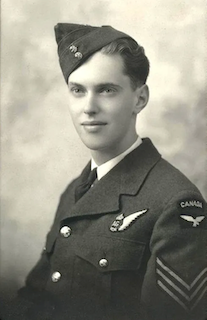
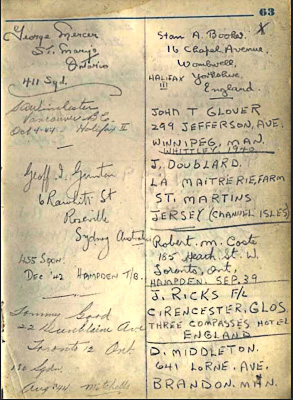
If there is a topic you’d like to see a blog written about, please don’t hesitate to contact me. I love hearing from you so keep those comments coming.
Share This:
Follow Stew:
Find Stew’s books on Amazon and Apple Books.
Please contact Stew directly for purchase of books, Kindle available on Amazon. Stew.ross@Yooperpublications.com or Contact Stew on the Home Page.
Shepherd.com is like wandering the aisles of your favorite bookstore.
Do you enjoy reading? Do you have a hard time finding the right book in the genre you enjoy? Well, Ben at Shepherd.com has come up with an amazing way to find that book.
Shepherd highlights an author (like me) and one of their books. The author is required to review five books in the same genre. So, if a reader is interested say in cooking, they can drill down and find specific books about cooking that have been reviewed by authors in that category. Very simple.
If you like to read, I highly recommend you visit Shepherd.com. If you do, please let me know what you think and I will forward Ben any suggestions or comments you might have.
Click here to visit Shepherd’s website.
Click the books to visit Stew’s bookshelf on WWII.
Check out Stew’s bookshelf on the French Revolution.
Please note that we do not and will not take compensation from individuals or companies mentioned or promoted in the blogs.
 Walks Through History
Walks Through History
Copyright © 2024 Stew Ross









